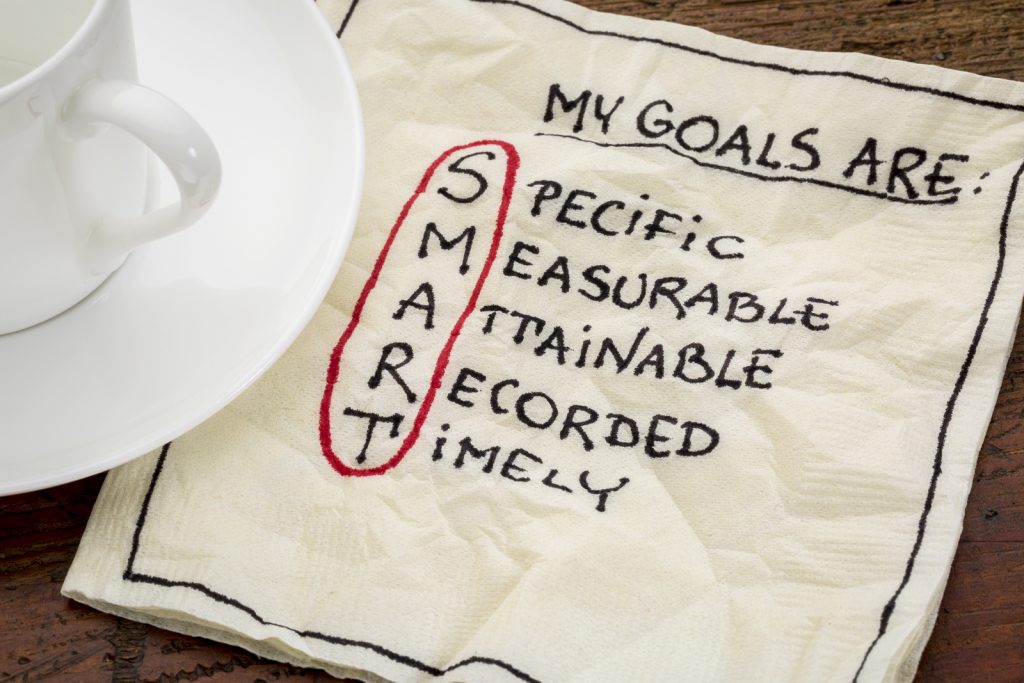We’ve all heard quotes like, “A goal without a plan is just a wish” and other motivational, feel-good maxims. In fact, most people do set goals, especially on New Year’s Eve.
That’s what New Year resolutions are. It doesn’t matter whether your resolution was to lose weight or make a million dollars. These are goals. However, setting a goal and reaching it are 2 totally different things.
The unfortunate truth is that most people never have the commitment, consistency and fortitude to stay on track until they reach the goal destination. In this article, you’ll learn what SMART goals are and how to apply them.

- What is a SMART Goal?
SMART is an acronym that’s used to define the 5 qualities a goal should have: - S – Specific
- M – Measurable
- A – Achievable
- R – Relevant
- T – Time-bound
Now let’s see what these terms really mean…
*Specific
When setting a SMART goal, the first point to note is that it has to be specific. For example, if you’re overweight and hope to shed the stubborn pounds, setting a goal like, “I want to lose weight!” is a valiant but incorrect goal.
It should be specific. How much weight do you want to lose? 1 pound? 40 pounds?
A goal such as, “I wish to lose 40 pounds”… is specific. Excellent, but we’re not done yet.
*Measurable
Is there a way you can measure your progress in the above example? Of course, there is. You can weigh yourself on a weighing scale or use a measuring tape to see if the inches have come off. There must be a way to measure your progress.
If you have a goal of getting fit, how will you measure it? How will you even know?
Setting a measurable goal will help. If you run a mile in 7 minutes, setting a goal of running a mile in 6 minutes will be measurable and of course, you’ll need to be fitter to pull it off. So, always ensure that you can measure your progress.
*Achievable
This is a tricky factor because there’s so much talk about thinking big and setting BIG goals. Aiming to be the best is a good thing, but you have to be realistic.
If you’re 40 pounds overweight, your goal of winning a professional bodybuilder in 6 months is NOT achievable. It may sound good and motivational – and has a lot of “oomph!” factor to it, but you’ll never pull it off if you don’t do it in stages.
The first step will be to lose all your excess fat. That should be your initial goal. Shelve the bodybuilding ambitions for now. Once the weight has come off, now you can set a goal of gaining 10-15 pounds of muscle.
Once that’s done, you can move on to the next step and so on. In the short term, set achievable goals that won’t overwhelm you.
*Relevance
Just because you can do something, doesn’t mean you need to. It’s imperative to ask yourself if your goal is something you truly want. Far too often, people set goals just because they’re influenced by what other people have.
For example, if you’re influenced by the lifestyle photos that some millionaire is constantly posting on Instagram, your goal might be to become a millionaire.
But is that what you want?
Most people would be more than happy earning 50 thousand more a year than they currently are. The sacrifices required to make a million dollars may be too much for them to bear… and why should they, if they’ll be perfectly happy earning $150,000 a year?
So, ask yourself what you REALLY want…, and if your goal is something that’s important to you and aligns with your values.
*Time-bound
Canadian businessman, Robert Herjavec, once said, “ A goal without a timeline is just a dream.” He’s right.
Your goal needs a deadline so that it lends impetus to your endeavor. Once again, we need to be realistic here.
Rome wasn’t built in a day… but they were laying bricks every hour. Following the example above regarding weight loss, if you wish to lose 40 pounds, most weight loss books will tell you that losing 1-2 pounds a week is healthy.
That means it will take you about 10 to 20 weeks to shed all 40 pounds. This is a realistic time frame. In fact, it’ll usually take longer because your body needs time to adapt and you may hit a plateau.
What if you set a goal to lose all 40 pounds in 4 weeks?
This will be a very unrealistic time frame. No matter how hard you exercise or starve yourself, achieving this goal is highly unlikely, and even if you do, it will not be healthy or sustainable.
You’d be better off setting a more reasonable deadline. If you still have not met your goal by the deadline, don’t panic or feel discouraged. This is normal. Worthy endeavors always take longer than you expect.
Move the deadline by another month or a few more months depending on the goal… and keep moving ahead without losing steam. That’s how you achieve your goals.
Now that you’re aware of the SMART way of setting goals, do evaluate your current goals and see if they meet these criteria. Once you have your SMART goals set, look at them daily (and write them down daily) to sear them into your mind so that you’re always acting in accordance and alignment with them until you achieve your goals.
“Keep your eyes on the stars, and your feet on the ground.” – Theodore Roosevelt
